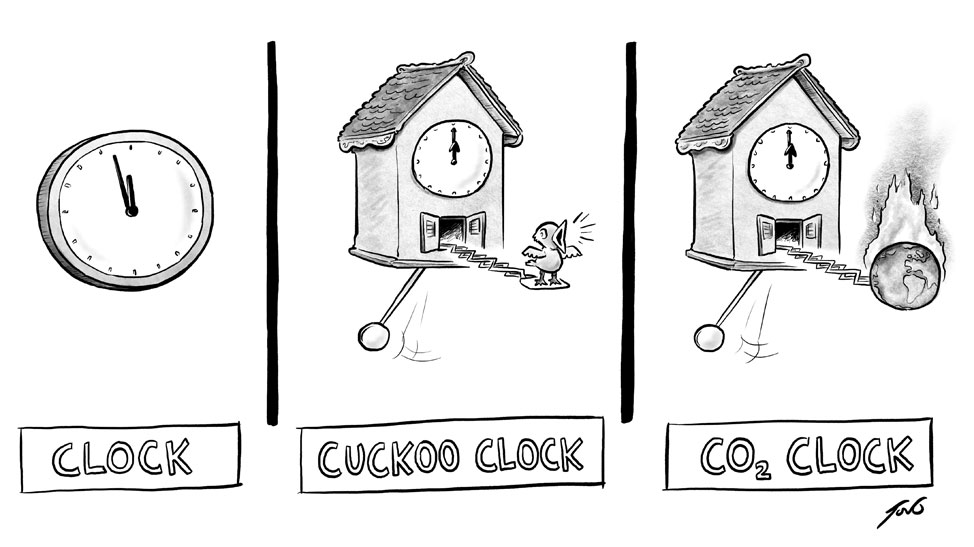
This is a re-post from Yale Climate Connections by Bud Ward

As sentient but fallible human beings, we often are cautioned about excessively watching the clock.
Even on their worst days, we all know, they’re right at least twice daily.
Watching the clock has its rightful place in many practices. Take the various shot-clocks in basketball or the five-seconds in which to pass the ball in bounds, the service clock in pro tennis, the delay-of-game clock in football.
In the climate change policy context, the clock can be both enemy and friend. Who can forget how many times we’ve been warned – albeit with lots of leeway in varying from the original reference – about having “only 12 years” remaining in which to, as the story gets infinitely re-told and restated, save the world and all humanity?
There are clocks. And there are clocks. Some are said to speed along at warp speeds, and some seem never to advance at all. It’s all in who’s doing the watching and time-keeping. So beware.
Something now in vogue among many eager to see real action on addressing global warming is word that only about nine months remain to take serious action: That is, to address our fossil fuel gluttony. For purposes of discussion, let’s say that takes us through about the end of July 2021, give or take a smidge.
This current doomsday clock is fueled by 1) a preference for a preferred outcome in the presidential election now 28 days away; and 2) the notion that the first six months of any new administration is the period most ripe for major legislative action. So from the January 20, 2021, presidential inauguration date, go out about six months.
Lots of variables and unknown unknowns go into this thinking, of course, including primarily who is or is not elected and inaugurated come January 2021; and, of course, the importance of the winning candidate’s having, or not having, a supportive majority in both the Senate and the House to help move along priorities.
One need not think too hard to remember that the incoming Obama administration in 2009 had drawn just such a straight flush but then – whether rightly or wrongly – chose to advance a public health rather than an energy/climate agenda. Whether that in fact was or was not the “right” decision is at this point irrelevant.
The incoming 2021 administration, under either candidate, unquestionably will face a challenging and expanding range of priorities: bringing to a smooth landing the nagging COVID-19 pandemic certain to still be on the public’s mind; social and economic challenges involving and going beyond racial equity and inequality; a bewildering range of foreign policy hot spots; a need to “fix” wrongs perceived by one side as having been inflicted over the past four years, or, on the other hand, to maintain and perhaps even accelerate the rate of fence-building (literal and rhetorical), deregulation, nationalism/”America First,” and much more.
One thing interesting about watching the countdown clock, below, is that the usual metric may in fact be a major impediment to progress. In the end, it’s not seconds, minutes, hours, days, weeks, months, or even years that are most important about this danged clock.
Instead it’s the constant ticking of additional greenhouse gas emissions into the atmosphere that mount with each tick, showing how much time remains to prevent global average temperature from passing the aspirational threshold of no more than 1.5 degrees C above pre-industrial averages.
Source: davidusher.com
Clocks surely have their rightful roles. Their alarm, or bell, wakes us up, tells us we’ve missed an action deadline, alerts us. And in so many cases, we avoid or disregard them at our peril.
Tick-tock, tick-tock, and so on until the countdown gong sounds. For whom does that bell toll? In this case, it’s for the planet, or at least for humans wanting to avoid causing serious harms to that planet, the only one we have.
Tom Toro is a cartoonist and writer who has published over 200 cartoons in The New Yorker since 2010.
Posted by Guest Author on Monday, 9 November, 2020
 |
The Skeptical Science website by Skeptical Science is licensed under a Creative Commons Attribution 3.0 Unported License. |